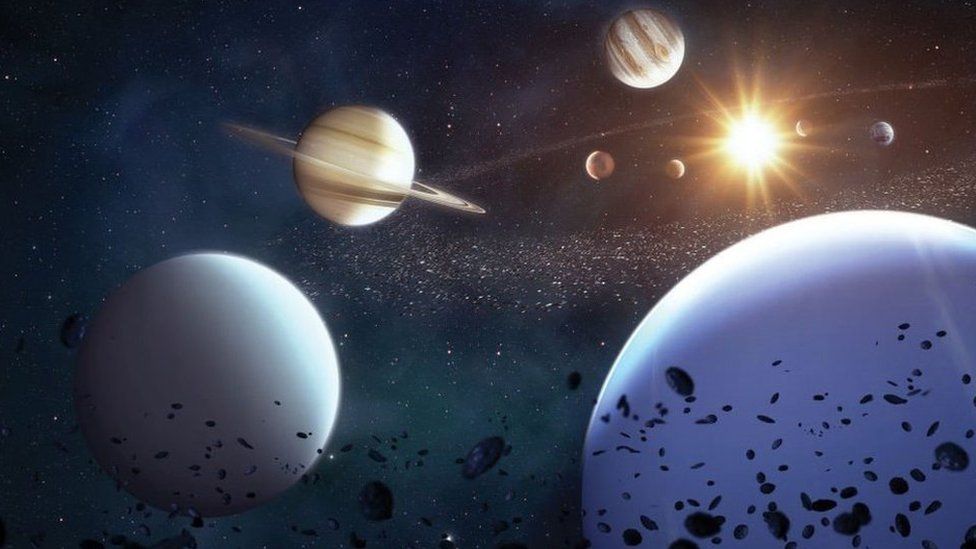The stargazing highlights for 2022
- Published

2022 is shaping up to be an excellent year for astronomy. In this handy guide we highlight the planets, constellations, conjunctions and other stargazing delights to look out for.
February to March
Whilst the Quadrantid meteor shower kicked off 2022 and the Wolf Moon shone brightly in January, the icy world of Uranus, the seventh planet from the Sun, will be visible on 7 February.
It will be past Valentine's Day but Venus is on a date with Mars on 27 February, forming a rather wonderful conjunction. Venus will be visible in the early mornings throughout the first half of March too.
The spring equinox is on 20 March this year, marking the beginning of astronomical spring in the northern hemisphere, and British Summer Time begins on 27 March, so there will be one hour less daylight in the morning and one more in the evening.
April to June
Look out for Mercury appearing above the western horizon just after sunset on 10 April. You should be able to spot it with the naked eye until the end of the month.
The peak of the Lyrid meteor shower will be on 22nd April and the Eta Aquariids will be in action on the morning of 6th May. These meteors originate from material left behind from Halley's Comet in 1986.
The Lyrid meteor shower
This is also the time when the season of noctilucent clouds begins so keep a look out for them on a clear summer's night. They are illuminated by the Sun after it has moved below the horizon. You can find out more about them here.
Noctilucent clouds create a wispy scene an early evening sky
Early risers take note! A total lunar eclipse or Blood Moon, will be visible over South America, most of North America and parts of Europe and Africa, on 16th May.
The entire eclipse will last for more than five hours, ending at 07:50 BST UK time. However, UK observers will only be able to see the eclipse from 02:32 to 05:10 as the Moon will have set below the horizon by the end of this period.
The optimal viewing time to see the eclipse is expected to be between 04:29 and 05:06 BST.
A blood supermoon rises behind Somerset's Glastonbury Tor
July - September
A supermoon will brighten the skies on 13 July. Expect it to appear 14% larger and 30% brighter than usual.
The Perseid meteor shower is always a treat for stargazers; it will reach its peak on night of the 12 into 13 August, when 100 to 150 meteors can be seen every hour.
Unfortunately, this year the shower may be largely washed out by a bright Moon one day past its full phase, but it is still worth looking up to see if you can spot some of the brighter meteors and also catching a glimpse of the Moon of course.
The Perseid meteor shower over Corfe Castle in Dorset
There will be a rare occultation of the Moon and Uranus on 14 September, when one object passes in front of another, obscuring it from view. This is due to take place around 22:30 BST and should take about 50 minutes as Uranus passes behind the Moon.
October - December
The Orionid meteor shower on the night of 21 October and morning of 22 October is one to wrap up and look out for.
The Orionid meteor shower
Also the Taurid meteor shower, known as the 'Halloween Fireballs', is visible from the end of October to the start of December.
The 25 October is the date to grab your protective glasses for a partial solar eclipse! The Moon will pass across the Sun around 10:00 BST, obscuring it by about 15% and then disappearing from view at 11.45 BST.
A Partial solar eclipse is due in October
Uranus is back in action again over the next couple of months. On 9 November it will be opposite the Sun and at its closest to Earth.
If you missed it first time round, on 5 December we are treated to a second occultation of the Moon and Uranus, and on 8 December, Mars will disappear behind the Moon too.
The 21 December is the winter solstice and a few days later as the Sun sets on Christmas Day, we should be able to see a thin sliver of the Moon with Venus and Mercury hanging low in the south western sky, creating a rather magical end to the year.
Stonehenge in Wiltshire bathed in morning sunlight
If all of this is not quite enough to fill your stargazing boots, Dr Edward Bloomer, Public Astronomy Manager at Royal Museums Greenwich, is hoping the recently launched the James Webb Space Telescope (JWST) will start sending back ground breaking data and images.
"It was launched on Christmas Day 2021, and is a huge telescope, designed to fold origami-like in order to fit into the launch rocket, then unfold when in space," he said.
"Perfecting the alignment segmented mirror assembly will take several months, though I'm hoping they may release some early images, even the not-quite-perfect stuff, could be amazing."
The James Webb Space Telescope will hopefully send data back to Earth this year
"We're hoping for further insights into star formation, galactic evolution, planetary systems, perhaps even the origin of life! But by the mission's nature, we don't know everything it could expose."
"For me that's the most exciting, nerve-wracking aspect of things and why it is so interesting beyond just the mission team. We'll be learning as the data comes in, and we've no idea what could be revealed!"
As always, BBC Weather will be on hand with the latest forecasts for these events - you can follow us on social media where we also share some great Weather Watcher photos.